
The History of Rockets and Military Rocketry
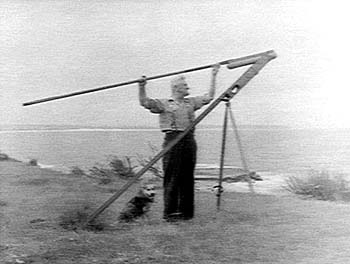 Swansea Rocket Brigade, Swansea, N.S.W.
Newcastle Morning Herald possibly 15/2/1956
Table of Contents
Rockets and Military Rocketry
The Rocket in the 20th Century Offensive uses of rockets during World War I were primarily used by that of the French, who used small solid-fueled rockets called La Prieur rockets after their inventor, Naval Lt. Y.P.G. La Prieur. Designed to be fired from French or British bi-planes against German observation balloons, they were not the only rockets in use during World War I. The British would add the A.T. and U.S. Kettering Bug rockets, both considered to be the first guided missiles (Lethbridge). British guided missile studies began in 1914 under the direction of Professor A.M. Low. The project was named A.T. for "Aerial Target" so that enemy spies would believe the vehicles were simply drones flown to test the effectiveness of anti-aircraft guns. Later, in 1917, the Kettering Bug was developed. The Kettering Bug was a pilotless bi-plane bomber made of wood and weighing only 600 pounds, yet it carried a 300-pound payload. The Kettering Bug was also the precursor the Larynx, which was developed much later. Introduced in 1927 by British Engineers at the Royal Aircraft Establishment, it was in essence, a remote controlled mono-plane that carried a 250-pound payload up to 100 miles away from its point of origin to its destination at speeds of up to 200 miles per hour. World War II, however, would the demonstration of the first, true, long-range destructive rocket, the A-4, or its more familiar name, the V-2 rocket. It was the V-2 that "would go on to lay the cornerstone of modern rocketry" (Lethbridge). After World War II, the same German scientists behind the V-2 came to the United States and brought with them their model. The V-2, over the course of 13 years, evolved into the modern-day rocket which, on October 4, 1957 carried Sputnik, the first artificial satellite ever to orbit Earth, into space. Thus commencing the rocket's adaptation from it's original intent to kill, to a new and bold use, that of discovery and exploration.
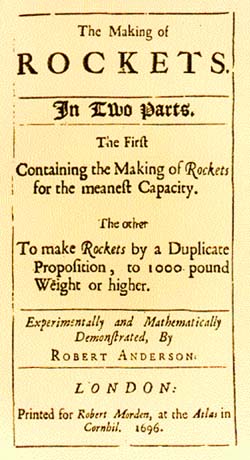 Anderson, Robert, The Making of Rockets In 1696, Robert Anderson, an Englishman, published a two-part treatise on how to make rocket moulds, prepare the propellants, and perform the calculations http://history.msfc.nasa.gov/rocketry/09.html
History of the Rocket - 1804 to 1815 http://www.napoleonic-literature.com/Articles/Rockets/History_of_Rockets.htm
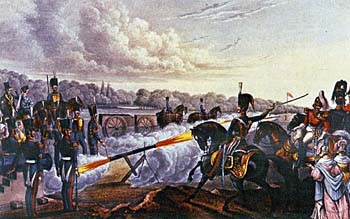 Spacelines's History of Rocketry
Part I: Ancient Times up to World War II http://www.spaceline.org/rockethistory.html
Part 2: Post-WWII
A Brief History of Rocketry
Encyclopedia Astronautica : Chronological Reference
Rocketry through the Ages : A Timeline of Rocket History
Schermuly and his Rockets
"The Rockets Red Glare"
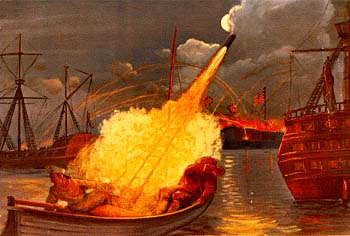 The Rockets Red Glare http://history.msfc.nasa.gov/rocketry/13.html
Francis Scott Key coined the phrase the "rocket's red glare after the British fired Congreve rockets against the United States in the War of 1812. Congreve had used a 16-foot guidestick to help stabilize his rocket. William Hale, another British inventor, invented the stickless rocket in 1846. The U.S. army used the Hale rocket more than 100 years ago in the war with Mexico. Rockets were also used to a limited extent in the Civil War. (Reproduced from a painting by Charles Hubbell and presented here courtesy of TRW Inc. and Western Reserve Historical Society, Cleveland, Ohio
The Start Spangled Banner, National anthem of the United States of America dates back to the War of 1812. During that war Frances Scott Key went aboard a British Frigate to negotiate the release of an important prisoner of war. Having arrived with another negotiator under a flag of Truce Mr. Key succeeded in getting the prisoner released, but fearing that the three men knew their plan of attack for the next day the British kept all three under arrest aboard the ship until after the Battle of Ft. McHenry. Sailing close to the fort the British used the super weapon of the 1800's, the Congreve rocket with Shrapnel bomb attached. The British were fortunate that these two men, Lt. Henry Shrapnel and inventor William Congreve were born in England and loyal to the crown. Lt. Shrapnel invented his artillery shell in 1784. It was adopted by the British in 1803. A shrapnel shell is designed to explode while still in the air over the enemy's head's raining down sharp pieces of metal on them. These shells were especially effective in a day and age when antiseptics were unknown and even minor wounds often lead to infection and death. It wasn't until WW I a century after the War of 1812 that military forces routinely equipped their soldiers with helmets to protect them from shrapnel raining down upon them. The shell adopted by the British in 1803 was designed to be fired from a cannon but as luck would have it another inventive Englishman, William Congreve heard about the shell and adopted it for his project. At about the time the shrapnel shell was adopted by the British artillery Corp the British army in India was fighting a war against the natives. During that conflict the Indian army used simple Rockets to bombard the British and set their army to panicking. William Congreve was intrigued by the reports of these Indian Rocket attacks and set out to equip his own countrymen with weapons to match them in battle. The Congreve rocket was the result. A Congreve rocket looks to the modern eye like a common bottle rocket used for 4th of July fireworks grown up. These Congreve rockets were built on 6 foot long poles and were fired from a light weight tripod, allowing them to be carried quickly to the front area of a battle field and fired at the enemy, or to be carried on a ship. Given that the common soldier of the 1600's was equipped with a black powder musket with a range of 75 to 100 yards a rocket that could fly 600 yards and explode over the enemy's heads was a deadly threat. Congreve rockets used Black gunpowder as both the fuel to fly and the explosive to send Shrapnel downwards. During the seige of Ft. McHenry the rockets flying from the decks of the British ships lit up the sky with their red exhaust and exploded about 100 feet over the heads of the American's holding the Fort. The bright explosions of these shrapnel bombs would throw a bright yellow glow across the fort when the exploded lighting up the Fort and showing the British that they were hitting the target. This is why Frances Scott Key wrote his famous poem which became the National Anthem of the United States thusly;
Oh say, can you see, By the dawn's early light,The 50 foot long flag with 15 stars and 15 stripes that inspired Frances Scott Key has been preserved in Washington D.C. and to this day draws thousands of tourists every year. The 15 stars and stripes flag is the only US flag that had more than 13 stripes for the 13 colonies that signed the Declaration of Independence in 1776.
Tipu Sultan (c.1750-1799) Tipu Sultan, Sultan of Mysore (now Karnataka) in southwestern India (from the death of his father, Hyder Ali, 1782.) He died of wounds when his capital, Seringapatam, was captured by the British. His rocket brigade led Sir William Congreve (1772-1828) to develop the weapon for use in the Napoleonic Wars.
Tipu's (Tipu Sultan-Ed.) contribution to Rocket Technology Rocket technology engulfed me for two decades since my visit to Srirangapatna in 1960. The question continued to haunt me - "How Tipu Sultan would have led to the world's first war rocket?" "What environment was responsible for the birth, of such a technological innovation in our country". In August 1974 I received a paper presented by Frank H.Winter of National Air and Space Museum Washington USA, titled "The Rocket in India from ancient times to the 19th century". This highly researched paper presented the 'Agni Astra' from Vedik hymns to Tipu's war rocket with eighteen classic references. Winter's conclusion is startling for the Indian Scientific Community. He says, "Thus, it is fair to suggest that the venerable rocket from the subcontinent of India may well have had its technological impact upon the West. If so, in retrospect, it was an important, if subtle, a technological transfer of recent history." Many such researchers have to spring up in our Universities as well. Soon, I learnt that two of the war rockets captured by British at Srirangapatana have been displayed in the Museum of Artillery at Woolwich in London. One of my missions during my visit to Europe in 1980 was to study this rocket. Dr.VR.Gowarkar and I visited the museum. It was a great thrill especially for Rocket technologists like us, to see an Indian innovation in a foreign soil well preserved and with facts not distorted. Under the heading "India's War Rocket", the following details are recorded in the Woolwhich museum London. The motor casing of this rocket is made of steel with multi nozzle holes with the sword blade as the warhead. The propellant used was packed gunpowder. Weight of the rocket is about 2kg. With about 1kg of propellant. 50mm in dia about 250mm length, the range performance is reported 900mts to 1.5 km. Our designers analyzed and confirmed their performance. What a simple and elegant design effectively used in war! The text above is an sourced from the homage paid to Tipu Sultan by, Dr. Abdul Kalam during the Hazrath Tipu Sultan Shaheed Memorial Lecture organised by the Al-Ameen Educational Society Bangalore on 30th Nov 1991. Dr Kalam is currently the Scientific Advisor to the ministry of Defence in India.
The History of Indian Rocketry, 30th Nov 1991
The story of Indian Rockets From Shrirangapattana to Shriharikota excerpt The British consider the Duke of Wellington, Colonel Arthur Wellesley (1769-1852), who defeated Napoleon at the famous battle of Waterloo (1815), one of their greatest national heroes. However, not many people know that this hero of Waterloo had to run away from the battlefield when attacked by the rockets and musket-fire of Tipu Sultan's army. It happened at the time of the Fourth Anglo-Mysore war (April 1799). General Harris led the British forces on the siege of Shrirangapattana, the capital of Tipu. The British forces had reached quite close to the fort of Shrirangapattana, but there was a formidable obstruction. To the south-west of the fort, near the village of Sultanpet, there was a large tope, where Tipu had stationed his rocketmen. Obviously, they had to be cleared out before the siege could be pressed closer to Shrirangapattana island. The commander chosen for this operation was Col. Wellesley. Col. Wellesley was not an ordinary Englishman. He was the younger brother of Lord Wellesley, the then Governor-General of India (1798-1805). Col.Wellesley, advancing towards the tope after dark on the 5th April, was attacked by a tremendous fire of musketry and rockets. The men gave way and retreated in disorder. In the midst of chaos that followed, Col. Wellesley lost his way, hid himself somewhere in the night and could report to Harris late only on the next day. The 'Sultanpet incident' had a profound and traumatic effect on Arthur Wellesley. His biographer Guedalla tells us that, even late in his life, after Waterloo, the unpleasing night lived vividly in Arthur's memory. After some days Gen. Harris planned another attack on Shringapattana. Help also came from Mumbai in the form of Gen. Stuart's forces. On the afternoon of 4th May when the final attack on the fort was led by Baird, he was again met by "furious musket and rocket fire". But this did not help much; the fort was taken. Tipu still refused to beg for peace on humiliating terms. He met a hero's end on 4th May while defending his capital. The taking over of Shrirangapattana was described by Arthur Wellesley, the future Duke of Wellington, in the following words:
Nothing therefore can have exceeded what was done on the night of the 4th. Scarcely a house in the town was left unplundered, and I understand that in camp jewels of the greatest value, bars of gold, etc., etc., have been offered for sale in the bazars of the army by our soldiers, sepoys, and followers....Along with the enormous loot another precious gift from India arrived in England. It was the Mysorean rocket, two specimens of which can still be seen in the Royal Artillery Museum, Woolwich Arsenal, London. European rockets of the time had combustion chambers made of wood or some kind of paste board. The metal cylinder (casing) used for the Indian rocket was hammered soft iron; it represented an advance over earlier technology. At that time iron made in India was of a high quality, even though Indian furnaces were small and inefficient compared with those of Europe. Indian iron was sent to Sheffield, because it was 'excellently adapted to for the purpose of fine cutlery'. The use of iron cylinder for the Mysore rockets increased bursting pressures, which allowed the propellant (gunpowder) to be packed to greater densities. This gave the Mysore rocket greater thrust and range. The metal cylinder was tied to a long bamboo pole or sword to provide stability to the rocket missile. From different accounts we come to know that the Mysore rocket weighed from 2.2 to 5.5 kgs. The metal casing was 4 cms in diameter and 10 cms long. The range is often quoted as about 1.5 kms. In exceptional cases it was upto 2.5 kms. There was a regular Rocket Corps of about 1200 men in Hyder Ali's army. Hyder's son Tipu raised it to about 5000 men. Furthermore, three or more rockets could be fired rapidly using a wheeled cart as a launch-pad. Though not very accurate, their flash and noise had much moral effect on men and beast when mass-fired. Rockets were in use in Karnataka long before the Anglo-Mysore wars. Hyder Ali's father was already commanding 50 rocketmen for the Nawab of Arcot. In the Second Anglo-Mysore war, at the Battle of Pollilur (10 September 1780), Hyder and Tipu achieved a grand victory, the contributory cause being that one of the British ammunition tambrils was set on fire by Mysorean rockets. The scene is depicted in a famous mural at the Darya Daulat Bagh in Shrirangapattana. An innovator in many ways, Tipu was greatly interested in rocket development. He showed great interest in such European inventions as barometers and thermometers and several other novel devices. Tipu had sent some of his rockets to the Sultan of Constantinople as presents. Rockets were known in India much before the Anglo-Mysore wars. Their early references are mostly from south India. The Mysore rulers might have got information about gunpowder and rockets from Malabar, where the Chinese used to come for trading. For fire-crackers words like 'china-bedi' and 'china-padakkam' are still in use in the Malayalam language.* Gunpowder was discovered in China in the ninth century A.D., when the first reference to the mixing of charcoal, saltpetre and sulphur is found. About the early eleventh century the Chinese developed a kind of incendiary arrow, in fact the rocket. We have descriptions of their use against the Mongols at the siege of Kai-Feng-Fue in 1232 A.D. It was through the Mongols or the Arabs that the know-how of gunpowder and rockets reached Europe in the thirteenth century. India also acquired the know-how of gunpowder about the same time, either through Chinese alchemists or through Chinese traders coming to Indian ports. Anyway, it is certain that by about 1400 A.D. the Chinese fireworks techniques were well-known in India. There is a treatise on fireworks in Persian written about 1450 A.D. by Zain-ul-Abidin, the Muslim ruler of Kashmir. In the fifteenth century A.D. various kinds of fireworks were displayed at Vijayanagar during festivals. Ain-e-Akbari gives a list of 77 weapons in the arsenal of Akbar, bana (rocket) being mentioned at the end. In fact, the word bana or agnibana in the sense of a rocket finds a place in several Sanskrit works of the mediaeval period. In China the tube of a rocket was made of bamboo. The use of iron tube for rocket is probably an Indian innovation. The British were greatly impressed by the Mysorean rockets using iron tubes. Several of them were sent to England, and from 1801, William Congreve (1772-1828), son of the Comptroller of the Royal Woolwich Arsenal, London, after thoroughly examining the Indian specimens, set on a vigorous research and development programme at the Arsenal's laboratory. Congreve prepared a new propellant mixture, and developed a rocket motor with a strong iron tube with conical nose, weighing about 14.5 kg. He also published three books on rocketry. It is important to note that Congreve, on the basis of Newton' third law, recognised one of the chief advantages of the rocket -- the absence of recoil force, making it suitable for sea-borne assault. In the first quarter of the nineteenth century the British used Congreve's rockets in several sea-wars, e.g., in a trial attack on Boulogne in 1806, in the siege of Copenhagen in 1807, etc. The rockets that Congreve ultimately developed weighed 20 kg with a range up to 2.7 km. Thus, from the above description it is amply clear that better rockets came to be developed in England only after experiencing and examining the Indian rockets. It was a time when in England the first wave of the Industrial Revolution and technical innovations had begun. Till the end of 18th century several products of Indian technology were much superior to that of the British, but there was no proper environment for their scientific development in our country. However, we should not forget that the plunder of Shrirangapattana and Tipu's rockets had also made a small but significant contribution to the Industrial Revolution that took place in England. - Gunakar Muley
b. May 20, 1772, London, Eng. d. May 16, 1828, Toulouse, France English artillery officer and inventor, best known for his military rocket, which was a great advance in black-powder rockets. It provided the impetus for an early wave of enthusiastic utilization of rockets for military purposes in Europe. Congreve based his rockets on those used by the Indian prince Hyder Ali against the British in 1792 and 1799 at Seringapatam. In 1805 he built a rocket 40.5 inches (103 cm) long, with a stabilizing stick 16 feet (4.9 m) long and a range of 2,000 yards (1.8 km). Congreve's rockets were used to bombard Boulogne, Copenhagen, and Danzig in the Napoleonic Wars and in the British attack on Fort McHenry, near Baltimore, in 1814, which inspired Francis Scott Key to write in the "Star Spangled Banner" (now the U.S. national anthem): ". . . the rockets' red glare, the bombs bursting in air." Congreve continued to improve his rockets' range and accuracy, leading many European countries to form rocket corps, usually attached to artillery units.
Congreve is also usually considered the first modern inventor to propose plating warships with armour (1805) to protect against artillery fire. Upon the death of his father in 1814 (whose baronetcy he inherited), he became comptroller of the Royal Laboratory of Woolwich Arsenal. From 1818 until his death, Congreve was a member of Parliament for Plymouth, Devon.
These were the first major use of rockets for the British army. The British had first encountered rockets being used in warfare at Seringpatam in 1792. Work to produce a British weapon was unsuccessful at first until the project was taken up by Colonel Congreve at the Royal laboratory Woolwich. By 1805 the British had introduced the first reasonably effective military rocket to European warfare. These early weapons were designed as incendiaries made up of layers of paper at first but later of sheet iron. In 1806, two hundred rockets were [launched] from 18 boats in 30 mins at Boulogne. In 1807 a massive 40,000 rocket attack did tremendous damage to Copenhagen mainly from fire. the rockets soon developed in sophistication with the fire rockets being used for sieges. A hollow iron head was developed which could be loaded with shell or rounds and the larger types with canister (musket balls with a charge behind them). Those used by the field artillery came in 4 sizes 6, 9, 12 and 18lbs. Although other nations did develop rockets after the British model only the British used them in action, with 2 rocket troops being shown as part of the Royal Horse Artillery (due to their speed) in 1813. The military use of rockets was in its infancy but the Congreve rockets, although of somewhat limited effectiveness in a field battle, paved the way for future developments which were to have a tremendous impact on modern warfare. TDP, 2 August 2000
Harpers Magazine, June 1854 : Page 1 | Page 2 | Page 3 | Page 4
The Congreve 32-pounder war rocket was the most widely used of the gunpowder-propelled war rockets of the early 19th century devised by the Englishman William Congreve (1772-1828). The 32-pounder could be fitted with either explosive warheads for use against fortresses or incendiary warheads for use against wooden sailing ships of the period. Those with incendiary warheads were called "carcass" rockets. Those with explosive warheads had round or ogival warheads. Those with incendiary warheads had conical heads, which was also used to stick into the targets and then burn....more
Hale, William, (1797-1870)
Hale 24-Pounder Rocket The Hale gunpowder war rocket of the last century was invented by the Englishman William Hale (1797-1870) in 1844 as a way to eliminate the cumbersome wooden guidestick of the Congreve rocket. The Hale rocket was therefore called the stickless, or rotary rocket, since it obtained its stability in flight by part of the exhaust gases causing the rocket to rotate or spin on its axis....more
 William Hale's Patent is announced in Scientific American, Apr 21, 1866 Download Hale's Patent
Space Exploration from Talisman of the Past to Gateway for the Future Excerpt When Napoleon threatened to invade England in 1804, William Congreve, a British artillery Officer, decided to develop a rocket weapon to destroy the French fleet across the English Channel. Inaccurate rockets had been used in great numbers as weapons in India from the 16th through the 18th Centuries, but they were used to frighten infantry troops and war elephants. These crude weapons were not very lethal, and Congreve learned about them because they were used by Indian Princes against British troops in the 1770s; the British military returned some of these weapons to Britain where they were displayed in an arms museum. It was here that Congreve studied, experimented, and developed his rocket system. This system consisted of 15 rockets carrying warheads of incendiaries, explosives, and great quantities of musketballs called case shot. The sizes varied from 3 pound rockets to 300 pound weapons propelled by an eight inch diameter missile. Congreve's rockets were much like the skyrockets of that time, except that his were larger and encased in sheet iron. A long stick on the side of the rocket stabilized it. In 1815, Congreve moved the guide stick from the side to the center of the rocket which, he found, gave the rocket far more stability and greater accuracy. Gunpowder was Congreve's fuel of choice; this powder propelled the rockets from 900 - 3000 yards. In 1806, Congreve's rockets were used successfully against the French fleet, destroying several French ships; these rockets also helped to almost destroy the city of Copenhagen during the Napoleonic Wars. After the success of Congreve's rockets nearly every army in Europe had its own rocket brigade. The Royal Artillery rocket troops successfully used their weapons during the War of 1812 against Fort McHenry near Baltimore, when Francis Scott Key described "the rockets' red glare" in the new American national anthem "The Star Spangled Banner." Additionally, these rocket troops employed their skills in Napoleon's downfall at Waterloo as well as in the Crimea in the 1850s. At this time another rocket was invented and used - the Hale Rocket. The main purpose of the Hale rocket was to eliminate the cumbersome guide sticks used by the Congreve rocket. The rocket achieved stabilization by rotating around its axis as it flew toward its target. The rocket accomplished rotation by having holes drilled in its rear, thus causing the escaping gas to flow in a circular motion naturally rotating the entire rocket. The drawback to this idea was that too much gas escaped thus reducing the range. Hale moved the holes to the center of gravity and found that too much gas was still escaping. Finally, frustrated with holes, Hale went back to Congreve's approach of using a guide, but instead of using a huge stick in the middle of the rocket he placed three guide vanes at the rocket's base which "guided" the flow of the exhaust and ballistically rotated the rocket. Hale also introduced a safer way to load powder rather than pounding it in by a hammer which had its dangerous moments. Hale's rockets were used by both sides during the U.S. Civil War and by the end of the 19th century were made obsolete by quick firing, rifled artillery guns. By this time many people were inspired by the possibilities which rockets and artillery pieces provided for exploring the final unknown frontier.
Books on Rocketry as listed by Amazon.com Winter, Frank H.: The First Golden Age of Rocketry; Washington, D.C.: Smithsonian Institute Press, 1990. Details of the Rocket System; Colonel Sir William Congreve The various applications of this weapon, both for sea and land service, and its different uses in the field and in sieges. SC, 37pp, illus., Royal Artillery. The Rocket System. With additional material by Captain E. M. Boxer and others; William Congreve, London, 1814. In 1804-1805, Congreve perfected a system of rocket artillery that was to be used by the British at Boulogne, Copenhagen and Baltimore. The original of the first part of the book was printed in 1814 as the promotional text book for the rocket brigade that was formed to service the new "secret weapon." To this has been added a retrospective appraisal by Captain E. M. Boxer who was in charge of British ammunition production in the 1850s, and a series of photographs of a contemporary model of the rocket car and limber, the rocket tube and rockets that were in use during the 19th Century. 85 pages, 35 illustrations
Rocket Brigades Rocket Brigades were mounted in most coastal towns in Britain and hence Australia (and presumably elsewhere) to assist vessels in distress usually those that had run aground on rocks, reefs etc. The rockets would both act as signals that help was at hand and also carry life lines to which larger tow ropes could be attached. from www.manorhouse.clara.net comes the following... A fisherman clearly wearing a Gansey (Guernsey - Ed.) which, upon closer inspection, is almost certainly that of the "Cullercoats Rocket Brigade" is shown running through the streets of a small northern fishing village shouting "All hands man the Life-Boat!" is dated 26 November 1887. Over a century later, the same pattern can be knitted, and in the same method, all-in-one piece, on five needles, in the finest quality 5-ply worsted wool. If the fisherman returned today, he would find a few things still familiar in Flamborough, and much that was alien. The fishing boats (known locally as "cobles") would still be instantly recognizable, as would Flamborough lighthouse and, if he walked into the premises of Flamborough Marine, upon my soul, he would find a match for his own Gansey.
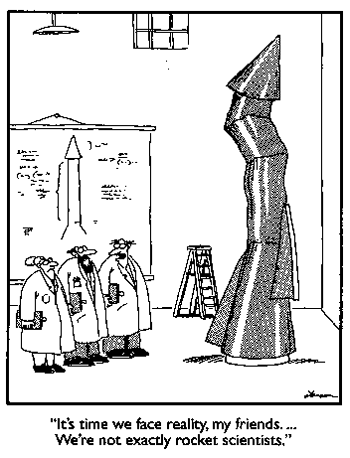
|
© Copyright 1999-2005 CTIE - All Rights Reserved - Caution |
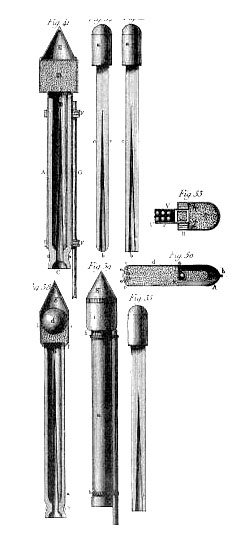 Congreve, Sir William, 2nd Baronet (1772-1828)
Congreve, Sir William, 2nd Baronet (1772-1828)